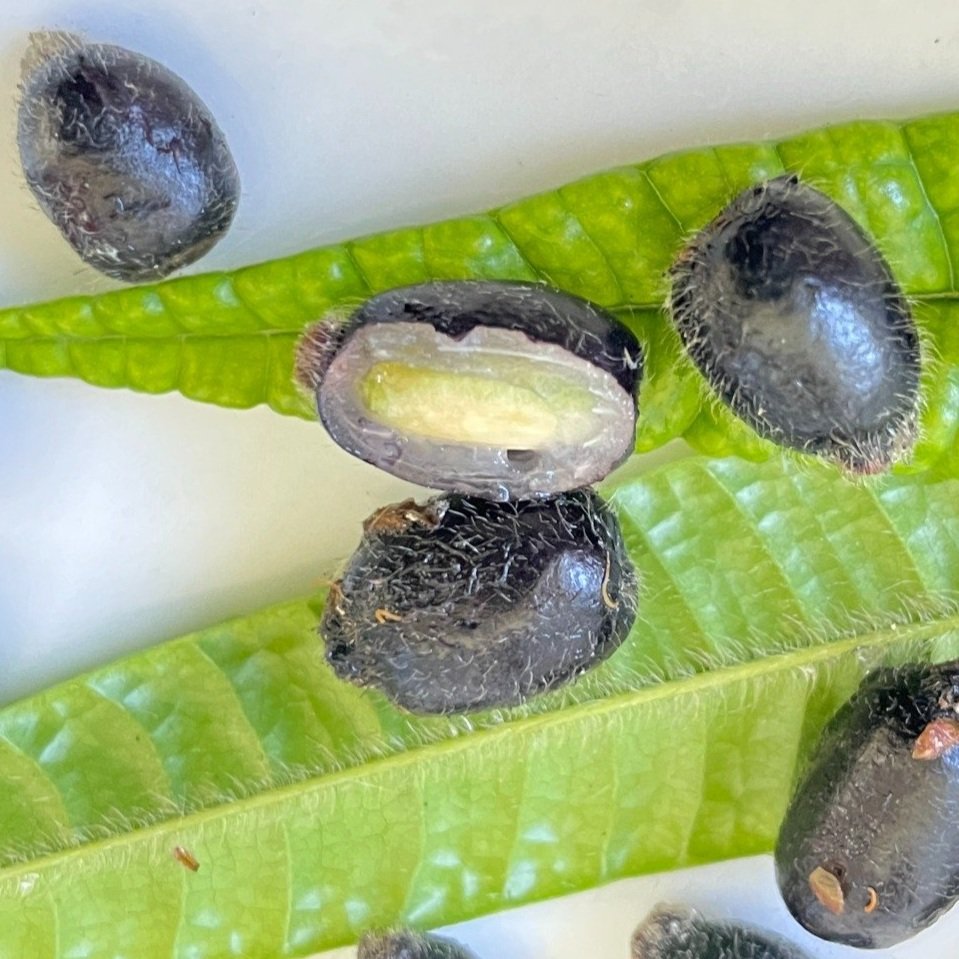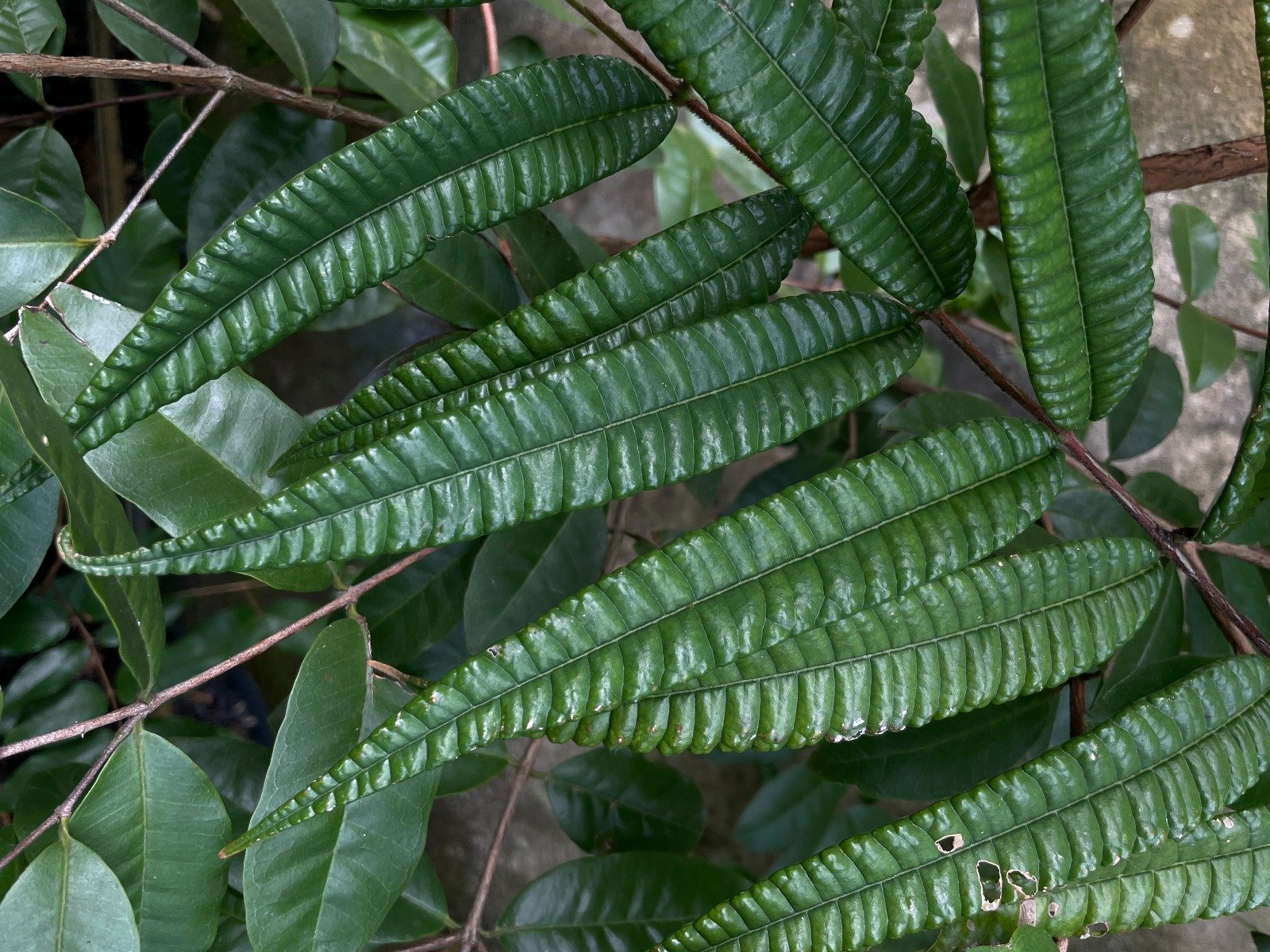 Image 1 of 7
Image 1 of 7

 Image 2 of 7
Image 2 of 7

 Image 3 of 7
Image 3 of 7

 Image 4 of 7
Image 4 of 7

 Image 5 of 7
Image 5 of 7

 Image 6 of 7
Image 6 of 7

 Image 7 of 7
Image 7 of 7








Myrcia Lacunosa - Bulged-leaved Guamirim - GERMINATED
Seeds were imported from Brazil. This small shrub features striking ornamental foliage with pendulous branches and pinkish-brown young shoots, making it a visual delight. It produces small, olive-shaped fruits with dark purple, slightly hairy skin and juicy white pulp that offers a sweet flavor with mild tannins. Ideal as a potted plant for indoors, small gardens, or bonsai, its fruits can be eaten fresh or used like other small berries from the Myrtaceae family. The melliferous flowers attract native bees, while the fruits provide food for small frugivorous birds. Native to the Atlantic Forest, it thrives in the undergrowth of semi-deciduous forests in Minas Gerais, where it was first discovered in the 19th century, and northern Rio de Janeiro, recently located by botanist João Marcelo Braga. It grows quickly for a Myrtaceae, fruiting within 2–3 years when cultivated in fertile, well-drained soils rich in organic matter and partial shade. Its narrow, bullate leaves resemble the prized foliage of Anthurium cutucuense (Araceae) and Inga congesta (Fabaceae), making it a favorite among collectors. Minas Gerais, located in southeastern Brazil, has a diverse climate ranging from tropical savanna (Aw) in lower altitudes to humid subtropical (Cwa) in higher elevations. The state experiences warm, rainy summers and mild, dry winters, with average annual temperatures between 18°C and 24°C (64°F to 75°F). Elevations play a key role in shaping the local climate, especially in areas like the Mantiqueira Mountains. Minas Gerais corresponds to USDA Hardiness Zones 9–11, with minimum temperatures typically ranging from -6.7°C to 10°C (20°F to 50°F), making it suitable for a wide variety of subtropical and tropical plants. Seeds are shipped in humid vermiculite.
Seeds were imported from Brazil. This small shrub features striking ornamental foliage with pendulous branches and pinkish-brown young shoots, making it a visual delight. It produces small, olive-shaped fruits with dark purple, slightly hairy skin and juicy white pulp that offers a sweet flavor with mild tannins. Ideal as a potted plant for indoors, small gardens, or bonsai, its fruits can be eaten fresh or used like other small berries from the Myrtaceae family. The melliferous flowers attract native bees, while the fruits provide food for small frugivorous birds. Native to the Atlantic Forest, it thrives in the undergrowth of semi-deciduous forests in Minas Gerais, where it was first discovered in the 19th century, and northern Rio de Janeiro, recently located by botanist João Marcelo Braga. It grows quickly for a Myrtaceae, fruiting within 2–3 years when cultivated in fertile, well-drained soils rich in organic matter and partial shade. Its narrow, bullate leaves resemble the prized foliage of Anthurium cutucuense (Araceae) and Inga congesta (Fabaceae), making it a favorite among collectors. Minas Gerais, located in southeastern Brazil, has a diverse climate ranging from tropical savanna (Aw) in lower altitudes to humid subtropical (Cwa) in higher elevations. The state experiences warm, rainy summers and mild, dry winters, with average annual temperatures between 18°C and 24°C (64°F to 75°F). Elevations play a key role in shaping the local climate, especially in areas like the Mantiqueira Mountains. Minas Gerais corresponds to USDA Hardiness Zones 9–11, with minimum temperatures typically ranging from -6.7°C to 10°C (20°F to 50°F), making it suitable for a wide variety of subtropical and tropical plants. Seeds are shipped in humid vermiculite.

